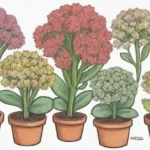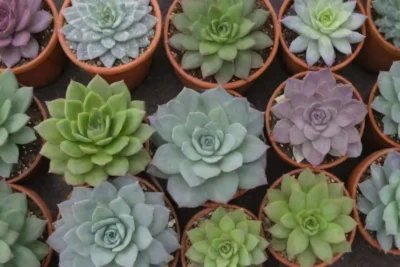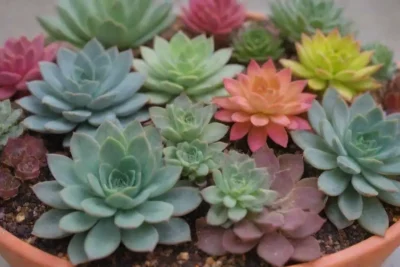
Understanding Agave Succulents: Characteristics and Care Tips

Introduction
Agave succulents are a fascinating group of plants that belong to the Asparagaceae family, showcasing a diverse range of shapes, sizes, and colors. Originating primarily from arid regions of North America, these drought-tolerant plants have gained immense popularity in gardens, landscaping, and indoor collections due to their striking architectural forms and low maintenance needs. Their reputations as hardiness champions make them ideal choices for gardeners and plant enthusiasts who want to showcase resilient species that can thrive in challenging environments.
This article delves into the unique characteristics of various agave species and provides essential care tips to ensure healthy growth and longevity. We will explore their physical attributes, growth habits, preferred environments, and the best practices for cultivating these stunning succulents in both outdoor and indoor settings. Whether you're a seasoned gardener or new to the world of succulents, this guide aims to equip you with the knowledge needed to appreciate and care for agaves effectively.
Unique Characteristics of Agave Succulents
Agave succulents exhibit a striking and distinctive appearance, characterized by their rosette formation. Each rosette is made up of thick, fleshy leaves that typically taper to a sharp point, offering a stunning aesthetic that can complement various design styles. The leaves are often serrated or spiny, providing added texture and visual interest. One of the most notable features of agave plants is their diverse color palette, ranging from deep greens to silvery blues, variegated patterns, and even hues of purple. This diversity makes them a favorite among landscapers and collectors alike.
Another distinctive characteristic of agave succulents is their growth habit. Most agaves grow slowly, often taking several years to reach maturity, but can live for decades. Each plant typically produces a single flowering stalk, which can reach impressive heights, sometimes exceeding 10 feet. After flowering, the plant typically dies, but not before producing numerous offsets or "pups" that can be transplanted and grown into new plants. This unique reproductive strategy not only ensures the continuation of the species but also provides opportunities for the gardener to expand their collection.
Additionally, agaves are incredibly well-adapted to arid environments. Their leaves are designed to conserve water, featuring a waxy cuticle that reduces moisture loss and specialized cells that help store water. This adaptation allows them to thrive in conditions where many other plants would struggle. Understanding these special adaptations is crucial for anyone interested in cultivating agaves successfully, as it informs the watering and care requirements that differ from more traditional gardening practices.
Growing Conditions for Agave Succulents
When planting agave succulents, one of the foremost considerations is the environment in which they will thrive. These plants prefer well-draining soil, ideally a cactus mix or a blend that includes sand or perlite to facilitate good drainage. Excess moisture can lead to root rot, a common issue with agave cultivation, so ensuring the soil allows for quick drainage is essential. Amending garden soil with grit or sand can improve drainage, making it more suitable for these succulents.
Sunlight is another critical factor in the growth of agave succulents. Most species thrive in full sun, requiring a minimum of six hours of direct sunlight each day. For indoor plants, positioning them near a south or west-facing window often provides the best light conditions. However, it's important to gradually acclimatize newly purchased agaves to bright light to prevent sunburn, especially if they were produced in lower light conditions at a nursery. For outdoor gardens, ideal locations are those that mimic their native desert environments, with plenty of direct sunlight and adequate space for air circulation around the plants.
 How to Differentiate Between Various Types of Cactus Succulents
How to Differentiate Between Various Types of Cactus SucculentsTemperature and humidity also play significant roles in the health of agave succulents. These plants thrive in warm temperatures, typically ranging between 65°F to 80°F (18°C to 27°C) during the growing season. They demonstrate a degree of cold hardiness, with some species capable of tolerating temperatures down to 20°F (-6°C). However, prolonged exposure to frost or excessive humidity can harm or even kill agave plants. Thus, in regions that experience freezing temperatures, it’s wise to plant them in pots that can be moved indoors or provide adequate protection during the colder months.
Watering Agave Succulents

Proper watering techniques are pivotal in caring for agave succulents. Their tolerance to drought does not mean they can thrive on neglect; instead, it indicates that they need a carefully managed watering schedule. During the growing season, typically spring and summer, agaves should be watered thoroughly but infrequently. The general rule of thumb is to allow the soil to completely dry out between waterings. Depending on environmental conditions, this could mean watering every two to four weeks.
When watering, always ensure that the water is directed to the soil rather than the foliage to minimize the risk of rot. Overhead watering can result in rotting leaves and an unhealthy plant. A good practice is to check the moisture level of the soil a few inches down before watering; if it feels dry, it's time for a drink. During the dormant season, usually in fall and winter, it’s best to significantly reduce watering, as agaves require very little moisture during this period.
Signs of overwatering can be readily observed in agaves. Factors to look out for include yellowing or mushy leaves and an unpleasant smell emanating from the soil. In cases of suspected root rot, acting quickly is crucial. Transplanting the agave into fresh, dry soil while trimming away any rotten roots can save the plant. On the other hand, if the leaves appear shriveled or curled, this may indicate the plant is thirsty and overdue for a thorough watering.
Fertilizing Agave Succulents
Fertilization is an important aspect of agave care, though it is often less critical than for other plants due to their slow growth and ability to thrive in poor soil conditions. A balanced, water-soluble fertilizer can be applied during the growing season to promote healthy growth. A typical recommendation is to fertilize monthly with a diluted solution. However, it’s essential to use fertilizers formulated for cacti and succulents, as these contain the appropriate nutrient ratios to support succulent growth without the risk of harming the plant.
When choosing a fertilizer, look for one high in potassium, as this will stimulate strong root growth and enhance flowering in agaves. A 2-7-7 or 3-9-6 formulation can work well for these plants. Furthermore, during the dormant season, it’s generally advisable to cease fertilization altogether, as agaves do not require additional nutrients while they rest. Over-fertilizing can lead to weak growth and an increased likelihood of pest problems.
 Sedum Varieties: Unique Traits and Growing Techniques Unveiled
Sedum Varieties: Unique Traits and Growing Techniques UnveiledBesides conventional fertilizers, some gardeners opt for compost teas or organic amendments that provide a slow-release source of nutrients. When using organic fertilizers, make sure they are well-aged to reduce the risk of burning the roots. Regularly monitoring the growth of your agave will help you assess whether fertilization is making a positive impact. If your plant appears vibrant, with robust leaf growth, then the fertilization regime you’re employing is likely appropriate.
Common Pests and Diseases
Although agave succulents are generally hardy, they are not entirely immune to pests and diseases. The most common pest issues that affect agave plants are mealybugs, scale insects, and aphids. Mealybugs, identifiable by their white, waxy coating, often cluster in leaf axils and can cause significant damage by sucking sap from the plant. For minor infestations, a cotton swab dipped in rubbing alcohol can effectively eliminate these pests. However, for severe cases, insecticidal soaps or horticultural oils may be needed.
Another pest to watch for is the agave weevil, an insect that can wreak havoc on agave plants. The larvae bore into the base of the plant, causing significant damage to the internal structure. Prevention is key; inspect new plants before bringing them home and avoid injuries to the plant, which could allow these pests access. If an infestation is detected, removing affected plants may be necessary to protect the rest of your garden.
In terms of diseases, root rot is one of the most prevalent issues affecting agaves, usually stemming from overwatering or poorly drained soil conditions. To combat this, ensure your planting medium drains well and adhere to a cautious watering schedule. Furthermore, fungal diseases may manifest as discoloration on the leaves. In such cases, removing and discarding infected leaves while ensuring proper air circulation can mitigate disease spread. Regular monitoring is essential, as early detection can prevent a small problem from becoming a larger one.
Conclusion
Agave succulents are truly remarkable plants, captivating both novice gardeners and seasoned horticulturalists alike with their stunning appearances and resilience. Understanding their unique characteristics, which include striking leaf formations and an impressive ability to thrive in arid climates, helps underscore the reasons why they have become so popular. By learning about their specific growing conditions, watering needs, fertilization practices, and how to combat common pests and diseases, you can create a nurturing environment in which these succulents can flourish.
As with any plant, patience and observation are vital when cultivating agave succulents. Each species has its own unique requirements, and understanding these differences can significantly enhance your success in growing them. Whether you're planting them in your garden, arranging them in pots on a patio, or showcasing them indoors, their edgy architectural shapes, coupled with the drama of their impressive flowers, can elevate any space they inhabit.
In conclusion, with the right tips and techniques in place, caring for agave succulents can be an immensely rewarding endeavor. There’s something wonderfully satisfying about nurturing these plants and watching them thrive. Remember to respect their native environments by adjusting watering, soil, and light conditions accordingly. With dedication and attention, your agave succulents will not only survive but flourish, adding a touch of the desert’s beauty to your life for years to come.
 Understanding the Pictorial Wonders of Fenestraria Succulents
Understanding the Pictorial Wonders of Fenestraria SucculentsIf you want to read more articles similar to Understanding Agave Succulents: Characteristics and Care Tips, you can visit the Types of Succulents category.




You Must Read